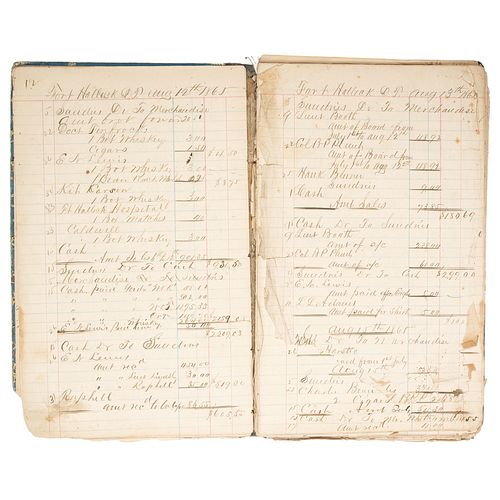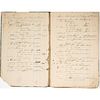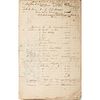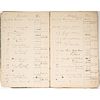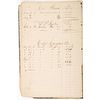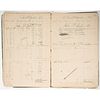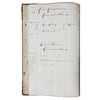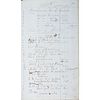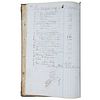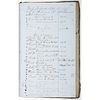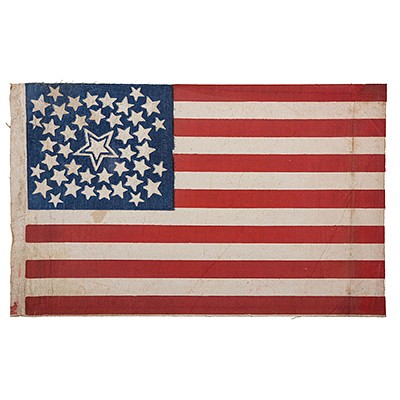Fort Halleck, Wyoming, Pair of 1865 Ledgers from the Military Outpost, Incl. Reference to Kit Carson
About Seller
6270 Este Ave.
Cincinnati , OH 45232
United States
With offices in Cincinnati, Cleveland and Denver, Cowan’s holds over 40 auctions each year, with annual sales exceeding $16M. We reach buyers around the globe, and take pride in our reputation for integrity, customer service and great results. A full-service house, Cowan’s Auctions specializes in Am...Read more
Two ways to bid:
- Leave a max absentee bid and the platform will bid on your behalf up to your maximum bid during the live auction.
- Bid live during the auction and your bids will be submitted real-time to the auctioneer.
Bid Increments
| Price | Bid Increment |
|---|---|
| $0 | $25 |
| $500 | $50 |
| $1,000 | $100 |
| $2,000 | $250 |
| $5,000 | $500 |
| $10,000 | $1,000 |
| $20,000 | $2,500 |
| $50,000 | $5,000 |
| $100,000 | $10,000 |
About Auction
Nov 19, 2020
Cowan’s Auctions, a Hindman Company, is pleased to present the November 19 Fall Auction, featuring over 400 lots of historically significant photography, manuscript material, artwork, and other ephemera dating from the 18th through the early 20th century, including the Civil War. Cowan's Auctions dawnie@cowans.com
- Lot Description
Lot of 2 ledgers, one measuring approx. 7.75 x 12 in., 113pp, and the other 8 x 13.25 in., 46pp, both with leather binding, marbled board covers, and lined paper. Ledgers document transactions occurring predominantly between July 13 aned October 4, 1865, at Fort Halleck [present-day southern Wyoming], a military outpost established along the Overland Trail in 1862 to protect emigrants, settlers, and stages from increasing attacks by hostile Plains Indians. The ledgers document hundreds of transactions for goods such as whiskey, tobacco, calico, playing cards, canned goods, hospital supplies, matches, and more, and may have been kept by the garrison's sutler or a clerk. Though the entries are not always identical, each ledger appears to document the same transactions over the same period. Ledgers identify purchases to legendary frontiersman Kit Carson, Army scout "Medicine Bill" Comstock, post-surgeon and diarist Dr. J.H. Finfrock, the Overland Mail Company, officers stationed at the fort, and others.A relatively large fortification, Fort Halleck had stables, residential quarters, a bake house, a store, jail, and its own hospital surgeon and staff. Thousands of emigrants and tens of thousands of animals would have passed through the Fort Halleck station before it was abandoned in 1866. Sutler stores were open to non-military travelers, so while the ledgers clearly document purchases from identified military personnel stationed at the fort they also document purchases from travelers who passed through the garrison. Such is the case for Kit Carson who on August 12, 1865, is listed as purchasing "1 Bot Whiskey" for the price of $3.00. William A. Comstock scouted briefly for the Army at Fort Halleck in the fall of 1865, and is almost certainly the "Bill Comstock" who made nearly a dozen purchases including "Nuts & candies" on September 9, 1865. Other notations include cash on hand, payments received, and indications an officer "Commenced Board."Located on one of the most dangerous sections of the Overland Trail, Fort Halleck reached its peak traffic in 1864-1865, a period covered in part by these ledgers. The transactions documented offer a fascinating glimpse into daily life at this remote outpost which played a critical role in protecting American interests while the country was engulfed in civil war. A historically significant and fascinating piece of western history.The smaller of the two ledgers is completely separated at the spine and disbound with pages loosely held together. Some pages have significant tearing, toning, folded edges, and wear. A few pages with losses affecting text. Larger ledger has damage to spine but remains bound; also has multiple pages with newspaper articles affixed over ledger content. Both ledgers appear to have been used after the closing of the fort and contain pencilled notations, doodles, etc. Fort Halleck notations typically remain legible in both ledgers except on pages where newspaper articles are affixed.
Condition
- Shipping Info
-
Buyers are required to pay for all packing, shipping and insurance charges. Overseas duty charges are the responsibility of the successful Bidder. Be aware that for larger and/or valuable items, shipping charges can be substantial. - If there is no shipping amount on listed your invoice, you will need to make arrangements to pick up or ship your purchase through an alternative shipping company. Our shipping department can be contacted at 513.871.1670 (ext. 219) or email shipping@cowans.com. - Shipping charges include insurance for your order while in transit. If you have private insurance we will adjust your charge to include only packing and shipping. - Please allow 14 – 21 days after payment to package and ship your purchase as carefully as possible.
-
- Buyer's Premium



 EUR
EUR CAD
CAD AUD
AUD GBP
GBP MXN
MXN HKD
HKD CNY
CNY MYR
MYR SEK
SEK SGD
SGD CHF
CHF THB
THB